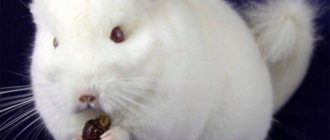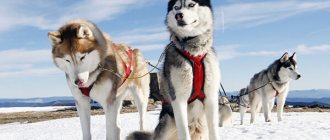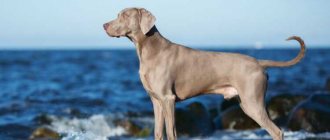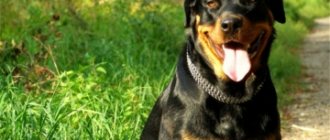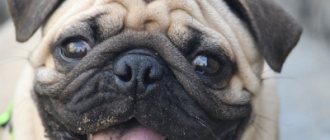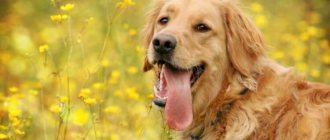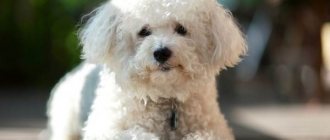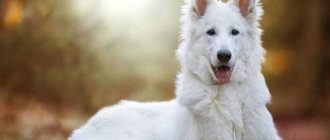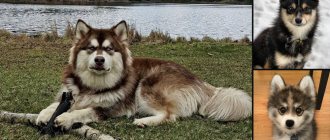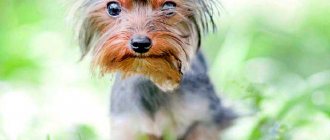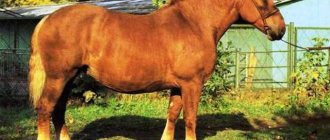Great Danes are one of the most popular breeds in the world. This is a fairly large, even gigantic dog with excellent guarding qualities. At first glance, she seems formidable and dangerous, but in fact she is not at all aggressive. Great Danes are smart, affectionate and loyal pets, loving children and unobtrusive. But due to their huge size, there may be problems in their maintenance. Therefore, before getting a Great Dane, you need to study the description of the breed and care features. Owner reviews will help you better understand the pros and cons of these pets.
- Description of the head
- Education and training
- Care
Description of the Great Dane breed
Popularity 73rd among 263 dog breeds
Lifespan:
8-10 years
Height:
males: 80-90 cm, females: 72-84 cm
Country of origin:
Germany
Average price:
20-40 thousand rubles
Weight:
50-80 kg
Latest articles Cat health
Ataxia in cats: what it is, how it manifests itself and is treated 01/23/2022 151 0 0
Cat health
Leukemia, or viral leukemia in cats 01/23/2022 140 0 0
Key facts
The country of origin of the breed is Germany, where the first official standard was developed. Before this, there were several names for the breed, which caused confusion among Europeans and was accompanied by slight differences in appearance. Now the description of the Great Dane breed is established and recognized by standards on all continents.
The maximum lifespan of a Great Dane is only 10 years, and on average these dogs live 5-7 years. The short lifespan is influenced by the size of the animal, which places a serious burden on the musculoskeletal system. According to the standard, the maximum height of Great Danes for males is 90 cm, and for females - 84 cm. A Great Dane named Giant George managed to exceed the established standards. The height at the withers of this dog was 110 cm and was recognized as the largest in the world.
Despite their stern appearance, Great Danes are intelligent and calm dogs. Aggression on their part can be seen only in one case - if the owners are in danger. The characteristics of the Great Dane breed explain that these animals will never offend members of their pack and will protect their owners to the last.
The most popular nicknames for males are Scooby Doo and Marmaduke, although the nature of these fictional characters is the exact opposite of real Great Danes.
History of the origin of the Great Dane
Great Danes are the oldest group of breeds, part of the Molossian dogs. The ancestors of the Great Dane fought in ancient battles as part of the imperial armies and competed in battles with wild animals in the fighting ring.
During the Middle Ages, the value of their strength fell in favor of speed and endurance. As a result of crossing with the British “boar dogs,” mastiffs acquired long limbs and an elegant body constitution. Animals began to be used for hunting and as personal incorruptible guards.
Until the end of the 19th century, in most European countries it was possible to meet your own “Great Dane”. This term did not characterize a specific breed, but was used in relation to particularly large dogs: Englische Dogge, Great Dane, Saupacker, Ulmer Dogge, Danische Dogge, Hatzrude, Grosse Dogge. All these animals had slight differences in phenotype, and in 1878 a group of enthusiasts from Berlin decided to classify them as a separate breed. After 2 years, the Great Dane was included in the lists of international cynological organizations. Germany was recognized as the country of origin.
The Great Dane is the official state symbol of Pennsylvania. This interesting fact is explained by the fact that it was the Great Dane that the first colonists brought with them.
Colors
There are a large number of dog coat color options. But for exhibition animals only 5 options are allowed:
- Pure black. There are no spots on the dog's body. Its dark fur has a beautiful natural shine. Small light spots on the neck are acceptable (only in females).
- Golden. Very beautiful coat color. Also shiny. There is short dark hair on the face and ears.
- Brindle. The main body shade is yellow or sand. Multi-colored stripes of different lengths and thicknesses are also visible. There is no shine.
- Black and white. The dominant color is white. Dark spots have different diameters. Most of them are on the face and back.
- Blue. Beautiful light gray color. There are no spots on the dog's body. It has a natural shine.
The Great Dane's fur is very short, and on any part of its body.
Appearance of a Great Dane
General impression
Great Danes are a striking example of a harmonious combination of strength and elegance. Thanks to its gigantic size, the breed is considered the tallest in the world, and one of its representatives was awarded an honorable place in the Guinness Book of Records.
“Germans” are considered to be giant breeds of dogs, so when you first meet them they evoke slight awe and respect. Powerful muscles, noble posture and clear proportions give the animal a resemblance to a skillfully made antique statue. The photo of the Great Dane immediately shows that the dog belongs to the “elite”
Head
All purebred representatives are distinguished by a long and narrow head. The brow ridges are well defined, but do not protrude. The lines of the skull and muzzle are parallel at the top points. If you measure the length of the stop and compare it with the distance from the frontal bone to the occipital bone, then the resulting values should coincide.
According to the standard, the description of the head includes:
- high-set, triangular-shaped ears hanging in a natural position;
- medium-sized round eyes with dark irises, tightly closed eyelids;
- wide nose with large nostrils and black lobe;
- dark lips with well-defined angles;
- developed jaws and strong teeth with a scissor bite.
Small deviations are acceptable in merle-colored animals: incomplete pigmentation of the lips and nose, light shades of the eyes or heterochromia.
In pictures in old books you can see that dogs used to have their ears cropped. Docking reduced the likelihood of injury during hunting, but has lost its relevance and is now performed solely for cosmetic purposes.
Neck
The head is set on a long and muscular neck. The position of the neck should be strictly vertical, only a slight bend forward is acceptable. The maximum width of the neck is achieved at the body, and the minimum at the head.
Torso
The shape of the body depends on the sex: square in males and more elongated in females. All purebred dogs have a tucked belly, a muscular and wide croup with a slight slope from the rump to the tail, a wide chest with mobile ribs and a wide, slightly curved loin. The highest point of the body is the withers.
Forelegs
Great Danes have strong and muscular forearms, longer than the shoulder blades, and straight elbows. Twisting of limbs is unacceptable and is considered a disqualifying sign. The cat's paws are well curved and end in strong black claws.
Hind limbs
The hind limbs are parallel to the front, and strong muscles are clearly visible on the thighs.
Tail
The tail, wide at the base, gradually tapers towards the tip. In a state of excitement, the tail rises, but not higher than the level of the back, and takes a saber-shaped position, and in a state of rest it hangs down freely.
Movement
In the video you can see that the gait of the Great Danes is accompanied by harmonious and flexible movements. When moving, the position of the limbs is parallel.
Wool
The body of the animal is covered with short and dense hair. The hairs are smooth to the touch and shine beautifully in bright light.
Color
The breed is characterized by many color variations in coat color, affecting the appearance of the pattern. Acceptable colors of the Great Dane include:
- Brindle. With a brindle color, the animal should have black stripes on its body and a black mask on its face.
- Black. Available in three variations: raincoat, deep black, platten.
- Pale yellow. Interspersed with blue, brown and gray are not allowed. A black mask is recommended.
- Marble (white with black spots). The main color is white (very rarely grey). Ragged black spots are scattered unevenly throughout the body.
- Blue. The limbs and chest may have white markings. The presence of black or white is unacceptable in this color.
Black and speckled Great Danes look especially impressive.
Size
In the photo of individuals of different sexes, sexual dimorphism is clearly visible. The minimum height at the withers for females is 72 cm, and for males - 80 cm. Due to the large skeleton and massive bones, adult males weigh at least 54 kg. The parameters of females are a little more modest. Their minimum mark starts at 45 kg. The average weight of a Great Dane is 50 kg. The size of the Great Dane means that the dog will be kept in a spacious room.
Argentine white
The only breed from Argentina that is officially recognized by the FCI. This is one of the most beautiful mastiffs - ideally built, stately, with smooth snow-white hair, proud posture. The dogs were created by Antonio Martinez in the 1920s, based on the Cordoba fighting dog. Also participating in the selection were:
- Great Danes;
- Pyrenean dogs;
- Bull Terriers;
- Bulldogs;
- Irish Wolfhound;
- English Pointer.
Each of the breeds gave the Argentine new irreplaceable qualities: strength, agility, large size, white color, good scent, power and speed.
Dog was bred as a hunting dog. It was used in a pack of hounds to bait pumas and other large animals. For such a purpose, only the most hardy individuals were selected, because the prey had to not only be caught up, but also defeated.
Externally, the Argentinean is large, heavy, grows up to 70 cm at the withers and weighs up to 50 kg. He has a strong, balanced rectangular body with prominent muscles, a long neck, a medium-sized dry head with small eyes. The coat is short, only white color is allowed.
Now dogs are used as guard dogs. They do an excellent job of protecting humans. Animals have developed intelligence, so they learn quickly and remember commands. But they require special education and professional training. In the family, Dogs behave calmly, not aggressively, respect their owners and children, and even love fun games. The average cost of the breed is 20,000 rubles.
Great Dane character
After the first interaction with a dog, it is not difficult to understand who is suitable for such a devoted and cheerful pet. Animals love to babysit children and need constant communication. You can hear a lot of positive feedback from owners about the friendly and intelligent character of the Great Dane.
The dog never barks idlely and is always ready to protect its owner. Any aggression on the part of an animal must be motivated by serious danger. A Great Dane will never attack a stranger or other animal without good reason. A pet with an aggressive or cowardly character is the result of abuse or poor training.
Adult animals behave more calmly than puppies. Active kids often forget about their impressive parameters, so they should not be left at home with small children unattended. If you have a Great Dane, try to provide him with constant company. He gets along well with other four-legged animals if he has known them since childhood.
For comfortable keeping at home, a private house with a separate plot is suitable. Living with such a huge pet in an apartment is possible, but it is inconvenient, and the loud stomping will certainly cause outrage among the neighbors living on the floor below.
But enclosure keeping of Great Danes is contraindicated. A scanty coat will not help them keep warm outside in winter and protect them from the scorching rays of the sun in summer. Living on the street also negatively affects the psychological state of the animal, which needs constant human company.
Education and training
The “Germans” not only have high intelligence, but also excellent memory. Raising and training a Great Dane should begin immediately after the puppy arrives in the home. Stick to a playful form of training that can arouse the interest of a small pet, and do not overload it with too complex and monotonous exercises.
Well-mannered animals never get into fights with other dogs, do not chew shoes and do not relieve themselves in the wrong place. All workouts should be done at a moderate pace. Don’t try to jump in over your head, but don’t mark time if your pet has long mastered the basics and is starting to get bored.
Any training is based on rewards and punishments. Everything is clear with “carrots,” but not everyone understands how to raise a dog with the help of “sticks.” Never hit a dog or scream. Such punishments seriously traumatize the psyche, so dog experts recommend using a change in intonation and ignoring. The pet does not like to be alone, so it is easy to manipulate.
After 5-6 months you can train outside with your Great Dane. In summer and winter, it is better not to overload the dog with exercise, and in spring and autumn, walking time can be increased. A trained pet must be able to walk next to its owner. This will help avoid conflict situations during walks.
How to find out the age of a pet?
If an adult Great Dane ended up in another home by accident, the new owners should try to calculate at least the approximate age of the dog. The number of years a dog has lived is determined by the condition of the animal’s coat, teeth and muscles:
- The young dog has prominent muscles and a lean body. As the dog ages, it loses mobility and begins to gain weight. The muscles of an elderly Great Dane lose their elasticity, and the abdominal line drops.
- The young dog has a silky shiny coat. With age, it becomes duller and begins to turn grey.
- You can tell an old Great Dane from a young one by their eyes. As a dog ages, his eyes become cloudy and dull. And the look of an elderly pet loses its liveliness.
- The most accurate way to determine age is by looking at the teeth. Up to 1–2 years, they are white and sharp. By the age of 7, the dog’s teeth gradually wear down and become yellow.
With this calculator you can find out the age of your dog by human standards. Read more.
Great Dane Health and Diseases
Possible diseases
The larger the dog, the shorter its life expectancy. The Great Dane's body wears out a lot by the age of 8, and most possible diseases are associated with large dimensions.
To increase life expectancy, do not forget about timely vaccinations recommended by your veterinarian. Visiting the veterinary clinic should be systematic. The earlier the disease is detected, the more successful its treatment.
The most common cause of early death is volvulus, which is explained by slow metabolism. Not only older dogs, but also young dogs suffer from this pathology. If you have difficulty breathing, vomiting or bloating, seek help immediately. The protracted nature of the disease is dangerous due to inflammation of the peritoneum, which ends in death without emergency surgery.
Great Danes often suffer from diseases of the musculoskeletal system: arthritis, osteomyelitis, bone cancer, dysplasia of the elbow and hip joints, Wobbler syndrome, osteochondrosis. This is due to the animal's gigantic growth, which places excessive stress on the joints and bones.
The breed is prone to eye pathologies (cataracts, glaucoma), early deafness, cardiovascular and dermatological diseases. Check your paws after every walk to prevent the development of interdigital dermatitis.
Histiocytomas, small benign neoplasms, often appear on the face, limbs and ears. In most cases, they go away on their own, but with severe itching and constant scratching, they require mandatory surgical removal.
Reproductive health
German females come into heat at 8-9 months and last about 20-21 days. Owners of small-breed dogs prefer that their pets go to the toilet at home during heat. This trick won’t work with a huge Great Dane, so you’ll have to fight the dog off from persistent suitors. If the birth of puppies is not planned, then it is better to take the pet for sterilization. The operation reduces the risk of developing pyometra, polycystic disease and breast cancer.
Planning for offspring is permissible after 22 months. At this age, the animal’s body is completely ready to safely bear puppies. Earlier matings are dangerous for mental disorders, miscarriages and difficult childbirth. The average length of pregnancy is 9 weeks.
Causes of premature death
The average lifespan of a Great Dane is extremely short. Most often, dogs of this breed die at a young age for the following reasons:
- hereditary and infectious diseases;
- lack of timely treatment;
- poor nutrition;
- physical activity that is not appropriate for the age and health of the dog;
- transport accidents;
- poisoning with toxic substances;
- improper conditions of detention.
Features of feeding and diet
Before buying a puppy, it is important to familiarize yourself with how to feed your Great Dane. Keeping such a huge pet is an expensive proposition. With natural feeding, adult animals eat at least 600 g of meat per day. The rest of the diet consists of cereals, dairy products, vegetables and fruits. When calculating the daily intake, it is necessary to maintain a balance of components. Eating too much food can lead to volvulus.
Feeding dry food is more expensive, but in this case there is no need for additional vitamins and minerals. Don't try to save on your pet's health by purchasing cheap food. Such products are harmful to the digestive system and have low nutritional value.
Be sure to check with your veterinarian to see if you can give your dog additional supplements. Too little or too much is dangerous for the body, so follow your doctor's recommendations.
Up to 2 months, puppies are fed at least 6 times a day every 3 hours. At 3 months of age, the number of feedings is reduced to 5 times a day, at 4 months - to 4, after six months - to 3, and after a year - to 2. Check with the breeder what food the puppies were fed before sale. Choosing another brand is possible, but the transition to it should be smooth. Gently mix the granules of the new food into the old, gradually increasing the ratio in favor of the new.
Particular attention should be paid to puppies, sick animals, pregnant and lactating dogs. Lack of calcium in puppyhood is fraught with osteoarticular disorders and spontaneous fractures. Calcium from milk is only suitable for puppies, as adult dogs develop lactose intolerance.
Do not walk your dog immediately after feeding. The incoming food is digested for at least half an hour. The digestive tract of “Germans” is 2 times smaller than that of other dogs. All products must be cut into small pieces, and the daily calorie content should not exceed 50 calories per 1 kg of animal weight.
Those who have given birth/have not given birth
Childbirth does not affect the average life expectancy of a pet. Bitches should not give birth too late, the optimal time for giving birth is from 2 to 3 years.
The advantages of childbirth are:
- The dog’s emotional sphere will receive a positive impulse, the pet will blossom with renewed vigor;
- Fulfilling a basic instinct.
Of the minuses:
- Unsuccessful childbirth can cause irreparable harm to the health of the bitch;
- Increases the chance of ovarian and uterine cancer;
- When puppies die, the dog may search for them for several months.
- Selling or giving away a puppy can be very stressful for the bitch.
Care and maintenance
Spring and autumn shedding in Great Danes is moderate. On these days, dogs need to be brushed 2-3 times a week, on other days - only once a week. For combing, a brush with soft bristles or a special massage mitt that does not injure the hairs is suitable. The short coat does not require trimming and remains clean for a long time.
The pet will have to be washed no more than 2 times a month with veterinary hypoallergenic shampoo. More frequent washing destroys the natural fat film and provokes the development of dermatological diseases.
To increase life expectancy, follow the basic rules for the care and maintenance of your Great Dane:
- Check the condition of your paws after every walk. Cracks on the paw pads are an open gate for harmful microorganisms.
- Trim overgrown claws. Accustom your dog to unpleasant procedures from childhood. When kept at home, claws rarely wear down naturally, so the pet must get used to visiting grooming salons.
- Monitor the condition of your ears, eyes and teeth. Increased secretion of sulfur, excessive tearing, unpleasant odors or inflammation of the oral mucosa require mandatory diagnosis.
Ideally, you need to find a veterinarian who will see your Great Dane regularly throughout his life.
Briefly about the main thing
- The progenitor of most breeds were mastiffs.
- Among them there are native breeds that have not been subjected to selection, which makes education difficult.
- Some Great Danes are considered endangered representatives of the group due to lack of demand for working qualities.
- They are distinguished by their external calmness, peacefulness, protective qualities, and unique appearance.
- No special care is required, just regular brushing is enough.
- He needs a competent selection of nutrition and education methods. Any manifestation of aggression or intolerance should be stopped immediately.
- The owner must have canine experience.
- A dog that is trusted to protect a home, territory, family. Has a positive attitude towards children and other pets.
- The variety of breeds allows you to choose a powerful, beautiful, stately puppy who will grow into a companion dog.
Tips for choosing a puppy
Not all owners know how to choose a healthy puppy and not run into scammers. Avoid selling by hand and advertising on free resources. Great Dane puppies in these places are often sold at a low price, but are rarely up to standard. Unscrupulous sellers save on maintenance, food and vaccinations by offering sick animals.
The maximum price for purebred dogs is set in large licensed nurseries in the capital, which are ready to confirm the origin of their pupils with the help of official documents. You can get advice on choosing a future pet from the staff, telling them your preferences.
Once you have decided on the place of purchase, get to know the puppies. They must be healthy and active. For sick dogs there should be a special isolation room that excludes close contact with other four-legged residents.
When making a transaction, the seller is obliged to conclude an agreement, provide a veterinary passport, birth certificate and pedigree. In some cases, the dog is microchipped in advance. This makes it easier to find and identify a lost animal.
How much does a Great Dane cost?
The cost for dogs with minor defects (improper placement of ears, deviations from acceptable colors) starts from 18-20 thousand rubles. Such animals have a good pedigree, but are not suitable for breeding or exhibition careers. Lower prices for Great Danes are justified by crossbreeding - mixing with other breeds. An adult mestizo can differ greatly from the standard, so saving on the purchase is pointless.
Breed and show-class animals cost at least 65 thousand rubles. Depending on the prestige of the nursery and pedigree, the price can reach more than 100 thousand rubles. When setting the final price, the seller includes all expenses incurred, so sterilized, microchipped and vaccinated animals always cost more than others.
Before purchasing, it is important to determine the purpose of getting a future pet. If you are looking for a companion dog, then do not overpay for the prestige of the class and choose a purebred pet with the “pet” classification.
Do you like the article? 0
Ear cropping
Previously, ear cropping was a mandatory procedure for all Great Danes. Its purpose is to protect against injury during hunting.
Now dogs play the role of companions, so there is no need for surgery. In addition, in many countries there is a ban on cupping - the procedure is considered inhumane.
The breed standard, in force since 1993, states that the ears must remain natural. According to veterinarians, a long ear flap better protects against dust, insects and infections.
In Europe, dogs with cropped ears are not allowed to participate in shows. There is no consensus on this matter in Russia yet. Many owners still crop their ears to make the animal look more menacing.
